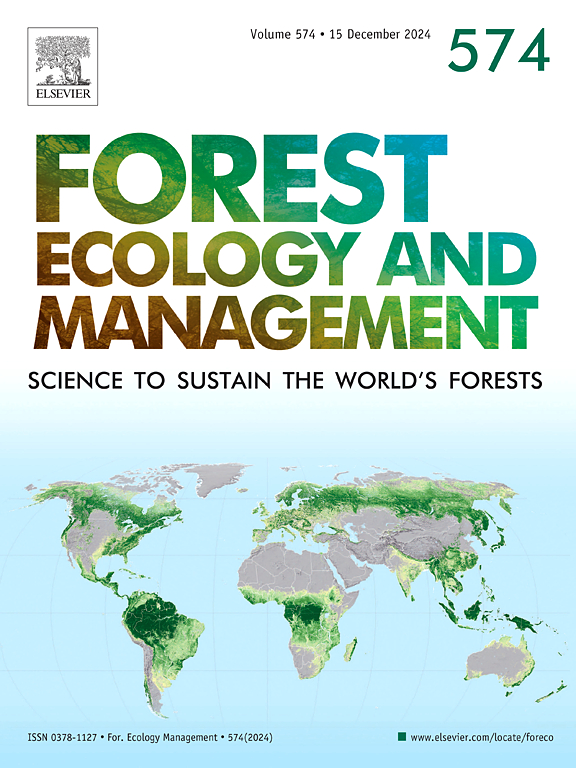Lack of large-diameter living trees and low structural diversity characterise managed dry-mesic oak forests in the Hungarian Carpathians
IF 3.7
2区 农林科学
Q1 FORESTRY
引用次数: 0
Abstract
Oaks are the dominant species of a wide range of forest types and are of great ecological, economic and cultural importance. Forest structure and composition have a major influence on forest function and biodiversity. It is a core determinant of naturalness, carbon storage and can be an important goal for forest management. We investigated the composition and structure in five age classes of dry-mesic oak forests in the Hungarian Carpathians. We collected standardised data from different stands and compared the structure (density, basal area, regeneration, dead wood, size distribution) and composition of oak forests among different age classes (40–165 years) and by management type (managed – abandoned). The effect of age class on the derived variables was analysed using general linear mixed models with age class as a fixed effect and region as a random effect. Oaks dominated all age classes in the canopy layer, with the combined relative basal area of oaks ranging from 95 % to 99 %. The composition of the understorey was very different from that of the canopy, with oak not dominating either the sapling or seedling size classes in any of the age classes. The diameter at breast height (DBH) range for age classes younger than 120 years old exceeds 28 cm on average, while in the oldest age class it reaches 45 cm. It is notable that large trees (DBH > 60 cm) are practically absent from the managed dry-mesic oak stands. The mean number of large trees per hectare was found to be 0.2 for all managed stands, while in the abandoned stands (with an age of over 120 years old) it was close to 5 trees per hectare. The diameter distribution of managed age classes exhibits a bell-shaped curve, whereas stands exceeding 120 years of age display a double-peak pattern, with the lower secondary peak occurring within the 35–40 cm diameter range. In order to facilitate the transition of dry-mesic oak forests towards a more natural state, it is crucial to ensure the preservation of intact areas and habitat trees, in addition to implementing appropriate techniques for their regeneration following felling. It is recommended that retention patches cover a percentage of the total area that is between 5 % and 25 %. Without leaving such immature patches, large trees will continue to be absent from dry-mesic oak forests in Hungary.
求助全文
约1分钟内获得全文
求助全文
来源期刊

Forest Ecology and Management
农林科学-林学
CiteScore
7.50
自引率
10.80%
发文量
665
审稿时长
39 days
期刊介绍:
Forest Ecology and Management publishes scientific articles linking forest ecology with forest management, focusing on the application of biological, ecological and social knowledge to the management and conservation of plantations and natural forests. The scope of the journal includes all forest ecosystems of the world.
A peer-review process ensures the quality and international interest of the manuscripts accepted for publication. The journal encourages communication between scientists in disparate fields who share a common interest in ecology and forest management, bridging the gap between research workers and forest managers.
We encourage submission of papers that will have the strongest interest and value to the Journal''s international readership. Some key features of papers with strong interest include:
1. Clear connections between the ecology and management of forests;
2. Novel ideas or approaches to important challenges in forest ecology and management;
3. Studies that address a population of interest beyond the scale of single research sites, Three key points in the design of forest experiments, Forest Ecology and Management 255 (2008) 2022-2023);
4. Review Articles on timely, important topics. Authors are welcome to contact one of the editors to discuss the suitability of a potential review manuscript.
The Journal encourages proposals for special issues examining important areas of forest ecology and management. Potential guest editors should contact any of the Editors to begin discussions about topics, potential papers, and other details.
 求助内容:
求助内容: 应助结果提醒方式:
应助结果提醒方式:


